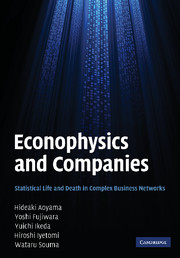Book contents
2 - Size distribution
Published online by Cambridge University Press: 06 August 2010
Summary
By looking at a wide range of companies, rather than individual organisations, a curious and somewhat mysterious pattern becomes evident in the rise-and-fall dynamics.
As a preliminary to examining the dynamics of groups of companies, we will first explain what we mean by the size of a company, and then introduce the important concepts of flows and stocks, and several tools necessary for examining the distribution of company sizes.
We will find that among ‘giant’ and ‘dwarf’ companies, the size distribution of giants obeys Pareto's law. We will also see that the same law is also found for flow quantities such as individual incomes, and we will touch upon its connection with inequality in society and how it is linked to macro-economics.
We can now turn to the strange world of company dynamics.
Preliminaries
Flows and stocks
Companies are economic agents that buy materials and services, create added value by utilising their own resources and earn money by selling the products. Thus, the key to understanding company behaviour is a clear understanding of money flows. Companies raise money, then use this capital to obtain raw materials, employees and facilities, and with these resources add value to products and services, which are then sold to obtain more money.
A company is usually legally obliged to communicate its financial situation to shareholders and creditors through audited accounts and statements, which, by and large, are in the public domain.
- Type
- Chapter
- Information
- Econophysics and CompaniesStatistical Life and Death in Complex Business Networks, pp. 14 - 58Publisher: Cambridge University PressPrint publication year: 2010



